Financial Markets Wrap - US Economy, Bonds, Currencies and Stock Market
Stock-Markets / Financial Markets Mar 18, 2007 - 11:07 PM GMTBy: Douglas_V_Gnazzo
Economy - The Labor Department reported a 0.4% increase in the consumer price index, which followed on the heels of a 0.2% increase in January. Core prices, excluding food and energy, were up 0.2%, and 2.7% from one year ago. Overall prices are up 2.4% from last year.
Food prices comprise about 20% of the CPI. They increased 0.8%, the most since April 2005, after a 0.7% rise in January.
Energy prices were up 0.9% in February, after losing 1.5% in January. Temperatures were much colder in February then in January, causing more demand for heating oil. Natural gas prices rose 5%. Gasoline prices gained 0.3%.
Housing costs account for one-third of the total consumer price index. Prices rose 0.4% in February after increasing 0.2% in January.
The National Federation of Independent Business reported that 13% more small-business owners reported higher selling prices last month.
Capacity utilization, a measure of the proportion of manufacturing plants in use, rose to a five-month high of 82% from 81.4%.
The Reuters/University of Michigan's preliminary index of sentiment declined to 88.8 in March, down from 91.3 in February.
Wages - The increase in food prices may be starting to affect worker's take-home pay. Hourly earnings adjusted for inflation fell 0.3%, the second such monthly decline.
Real hourly wages are up 1.8% since February 2006. Wages are up 2.2% for the last year ending Jan. 2007.
Inflation is stubbornly holding above the Fed's comfort level, while growth in the economy, especially considering the down turn in housing, and the weak manufacturing sector, is suggesting that stagflation may be developing. Not what the Fed wants.
Inventories/Sales - The U.S. Census Bureau reported that the combined value of distributive trade sales and manufacturer's shipments for January, adjusted for seasonal and trading-day differences, but not for price changes, was estimated at $1,057.8 billion, down 0.7% from December 2006.
Manufacturers's and trade inventories, adjusted for seasonal variations, but not for price changes, were estimated at an end-of-month level of $1,370.2 billion, up 0.2% from December 2006.
The total business inventories/sales ratio based on seasonally adjusted data at the end of January was 1.30. The January 2006 ratio was 1.25.
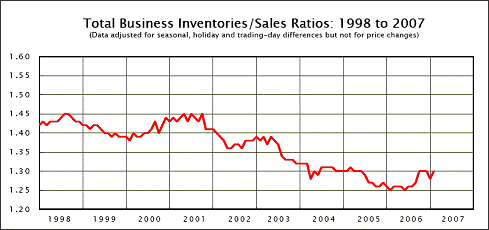
Subprime Loans - More than 30 subprime lenders have gone bankrupt in the U.S. since late 2006.
Delinquent payments on loans of all types rose to 4.95% from 4.67% during the third quarter of 2006.
Delinquencies will have a slowing effect on the economy, as its repercussions slowly filter through the system. The numbers are considerably worse for subprime borrowers, with 13.33% presently behind on payments.
Defaults could spread to borrowers with Alt-A or jumbo mortgages, a class of mortgages that represents $1.14 trillion in loans, or 12% of the entire mortgage market - according to Bear Stearns.
Subprime loans comprise 15.2%, or $1.45 trillion of total mortgages, and jumbo mortgages are $1.41 trillion, or 14.8%.
The National Association of Realtors reported that the median home price for existing homes was down 8.5% in January, from a peak of $230,000 in July.
The current downturn in home building could lead to a significant decline in employment, as approximately 40% of all jobs created between 2000 and 2005 were tied to the housing market, and housing and related industries account for about 23% of the U.S. economy.
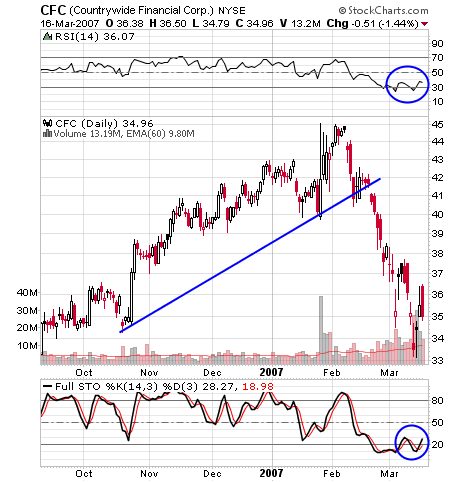
The above chart is of Countrywide Financial Corporation, the now infamous player in the subprime mortgage market. Will there be more downside - yes. Will there be further problems in the subprime loan area - yes.
Lehman Brothers has forecast that "mortgage defaults over the next two years may climb to $225 billion", while the Fed has stated that as many as "1.5 million more Americans may lose their homes".
Stocks - As everyone is well aware, stock markets around the world have had a rough go of it the last couple of weeks. Several reasons are usually given: the subprime loan issue; the unwinding of the yen carry trade; and just plain overall liquidation to meet margin calls.
The stock markets are all asset bubbles that have just been waiting to be popped. If it wasn't the subprime debacle, it would have been some thing else just as sinister, although we hasten to add that there does seem to be poetic justice running afoul.
Now market players are starting to question whether or not the contagion will be contained to the subprime market, or if it will spread to other sectors?
Symptomatic of these fears are the charts of the Financials Select Spyder (XLF), which provides an overall view of the industry; and Bank of America, which gives a more specifically focused example.
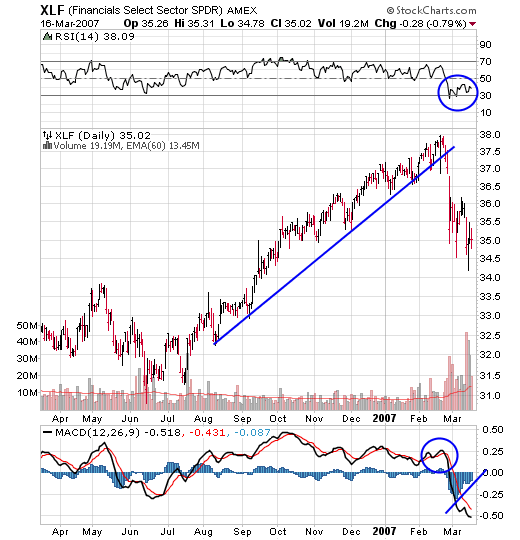
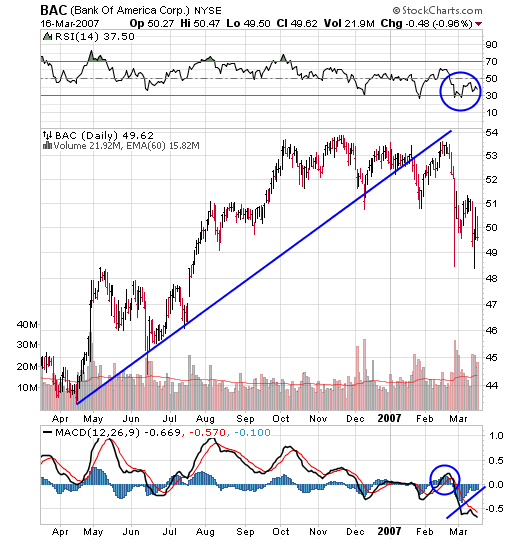
As can be seen - the contagion is spreading. Is there more yet to come, or is this all?
There is more yet to come, as after every boom follows the inevitable bust; until such time that Honest Money, as mandated by the Constitution: gold and silver coin, circulates as the currency of choice - free choice, not because of legal tender laws had by forced compliance.
The overall stock market has been feeling the pain as well. Below is a daily chart of the Nasdaq Composite Index, which has had a nasty break below its lower trend line, and is approaching its 200 ma.
There may well be a short term rally; however, more intermediate term downside action is likely.
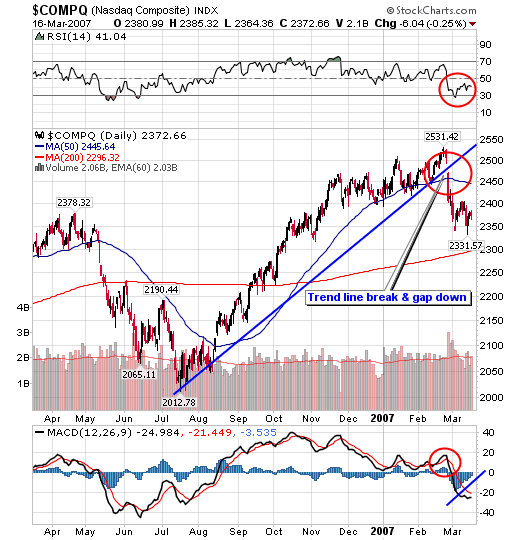
For the week the Dow lost 1.4%, and the S&P 500 fell 1.1%. The Transports were down 1.0%, while the Utilities gained 0.9%. Brokers dropped 3.1%, and the Banks declined 2.3%.
The amazing thing about the fall was not only how fast it happened, but how complacency was running rampant and the goldilocks economy/market mantra was on everyone's lips.
Below is a chart of the VIX Volatility Index, which shows the future expected volatility of the market. As the chart illustrates, it went from a low of 10 to a high of almost 20 in less then a month's time; and has since fallen and rallied by almost half as much - all within a few week's time.

Stock markets around the world have all been experiencing similar moves. Below is the point and figure chart for the Hong Kong Hang Seng Index that shows a bearish price objective about 5% lower.
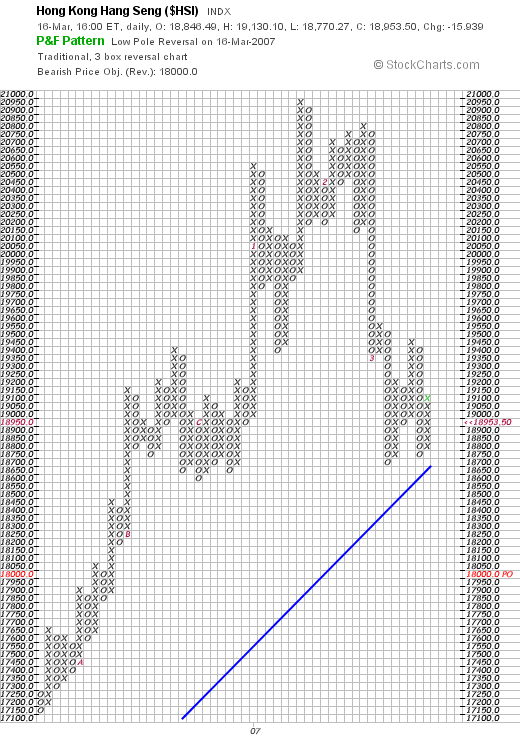
Bonds - Two-year government yields fell 8 bps to 4.59%. Five-year yields lost 6 bps to 4.47%. Ten-year yields were down 4 bps to 4.55%. 30-Year bond yields gave up two bps to 4.70%. The spread between the 2 year and the 10 year closed the week inverted 4 bps.
The Fed still has its inverted yield curve, but it's shrinking weekly. Will they be able to hold on or not? We believe any surprises in interest rates will be to the upside, which will only hasten to exacerbate the problems in the already weakening housing market.
Below is the chart of the ratio of the 30 Year Yield compared to the 5 Year Yield. We have also compared it to the performance of gold.

As the chart illustrates - gold moves inversely to the bond ratio. Notice how since April the bond ratio has been moving sideways - as has the price of gold.
Both have been locked in a trading range. Look for the direction that one breaks - to hint at the direction of the other.
Fed foreign holdings of debt increased $11.4 billion last week to a record $1.86 trillion, a 26% annualized increase.
U.S. Dollar - The US dollar index dropped 1.5% to 82.94 for the week. The dollar fell to its lowest level so far this year against the euro, and dropped versus the yen because of yen carry trades unwinding.
As the chart of the dollar below shows, the currency has broken below its lows from Jan. & Feb. Its Dec. 2006 low of 82.35 best hold or there will be trouble in paper fiat land.
Did Sir Alan know when to retire? What a nice present he left for Ben - to clean up, not that he or anyone could, within the presently existing monetary system. A thought: perhaps a different monetary system is needed.
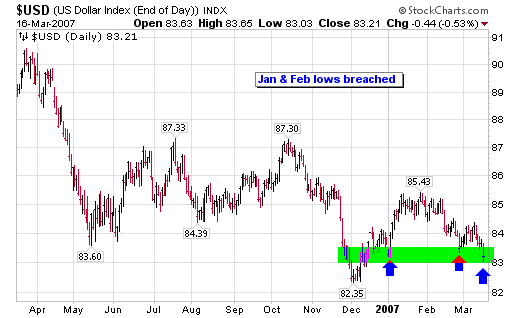
The point and figure chart of the dollar does not engender much hope, as it projects a bearish downside target of 78.00.
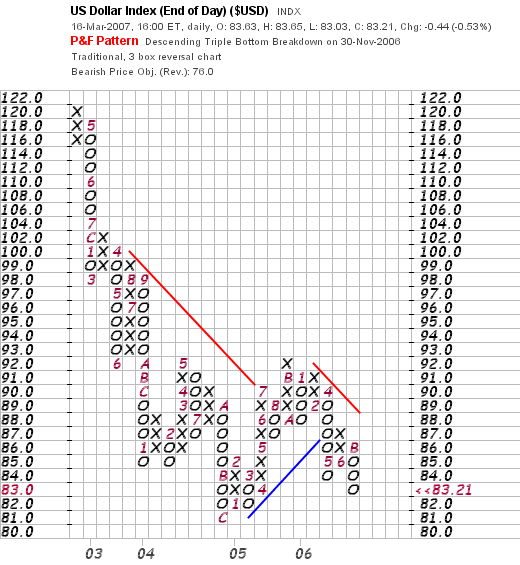
Due to the unwinding of yen carry trades; the yen has rallied as of late. The point and figure chart below still shows a bearish price objective of 76, which is over 10% lower from its present price.
This does not mean that such a price objective will or will not be reached. It simply is what the chart is saying right now. Charts like anything - can change overnight. The one thing that remains constant is that nothing remains constant and even that might not.
We have just seen the above play out in the world's stock markets.
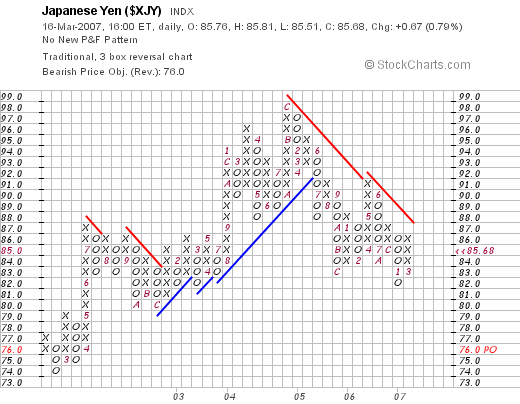
Next up is the euro/dollar chart. It shows the euro having just broken out to the upside. The future of the US dollar does not look too bright.
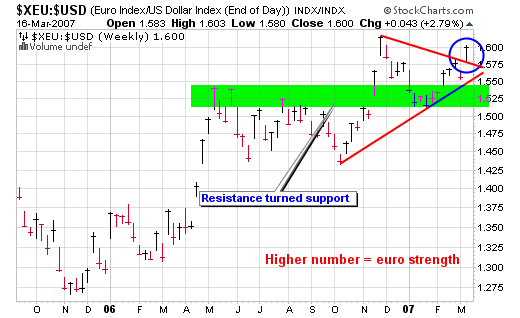
International reserve assets, excluding gold, were up $841 billion to a record $5.04 trillion for the week, a 20% year over year rate of increase.
Summary
Stock markets around the world have sold off from recent highs, due to worries over the subprime mortgage debacle, the Yen Carry Trade, and the subsequent selling of just about anything in order to meet margin calls. Liquidity, liquidity, and more liquidity is the name of the game.
The unwinding of yen carry trades has caused the yen to rally, and most other assets to be weak. The dollar is once again headed down, while the euro has turned up. U.S. Treasuries have been a "safe haven" from the turmoil of the stock market.
A short term rally may be in order; however, more downside action appears likely. We believe that a return to the bear market is in the cards to be dealt later this year.
The sub-prime loan problems, the unwinding of the carry trades, as well as the search for liquidity - are all gold positive. The only remedy the Fed has for anything is to create more money and credit.
Many have pointed to the fact that because gold hasn't gone up during such turmoil that it is a sign of weakness. Obviously it's a sign of weakness, as it hasn't gone up.
However, that does not preclude it from going up - nor does it provide any indication how high it will go up, or the timing of such a move up. It's a bull market until it isn't.
As the problems in the monetary, financial, and debt markets unfold, gold will be seen as the only asset that is no one's liability, and it will then shine brightest of all.
We plan on adding to positions when the 65 week ma is near, and we will also be adding to positions in the gold stocks when a higher low is kept intact.
A few words on China are in order. Recently they announced that they would be diversifying out of some of their $1.07 trillion dollars of currency reserves, the largest cache in the world.
With the announcement of a fund being planned to oversee the investment of a good chunk of their reserves, many around the world became concerned that China's purchases of U.S. Treasury Bonds might take a dive.
Prime Minister Wen Jiabao replied by saying, "our purchases of U.S. dollar assets are mutually beneficial, and we won't affect the value of U.S. dollar assets." China is the second largest overseas holder of Treasuries after Japan.
The Prime Minister also said that China's economic expansion, "is unstable and environmentally unsustainable. China's investment growth is too high, lending growth too fast, liquidity excessive and trade and international payments very imbalanced."
China's money supply grew 17.8% in February. They have the highest rate of non-performing loans in the world. Many are worried that China is going to take over the world.
This is all very similar to the talk of Japan taking over the world back in the 80's and 90's. Maybe - maybe not. I'd be more concerned with the elite international banking dynasties rising to power via their New World Order plans and taking over the world - not China.
Lastly, remember the term CDO's - collateral debt obligations. Several years ago I wrote that derivatives and the carry trade would become household words before all was said and done.
You can now add CDO's to that list as well - the worst of the worst. We ain't seen nothing yet. If ever there was ever a time for Honest Money - now is that time.
Invitation
Stop by our website and check out the complete market wrap, which covers most major markets. There is also a lot of information on gold and silver, not only from an investment point of view, but also from its position as being the mandated monetary system of our Constitution - Silver and Gold Coins as in Honest Weights and Measures.
There is also a live bulletin board where you can discuss the markets and other topics with people from around the world, as well as many other resources too numerous to list. Drop by and check it out. Good luck. Good trading. Good health. And that's a wrap.
Douglas V. Gnazzo
Honest Money Gold & Silver Report
Douglas V. Gnazzo is the retired CEO of New England Renovation LLC, a historical restoration contractor that specialized in the restoration of older buildings and vintage historic landmarks. Mr. Gnazzo writes for numerous websites, and his work appears both here and abroad. Just recently, he was honored by being chosen as a Foundation Scholar for the Foundation of Monetary Education (FAME).
Disclaimer: The contents of this article represent the opinions of Douglas V. Gnazzo. Nothing contained herein is intended as investment advice or recommendations for specific investment decisions, and you should not rely on it as such. Douglas V. Gnazzo is not a registered investment advisor. Information and analysis above are derived from sources and using methods believed to be reliable, but Douglas. V. Gnazzo cannot accept responsibility for any trading losses you may incur as a result of your reliance on this analysis and will not be held liable for the consequence of reliance upon any opinion or statement contained herein or any omission. Individuals should consult with their broker and personal financial advisors before engaging in any trading activities. Do your own due diligence regarding personal investment decisions. This article may contain information that is confidential and/or protected by law. The purpose of this article is intended to be used as an educational discussion of the issues involved. Douglas V. Gnazzo is not a lawyer or a legal scholar. Information and analysis derived from the quoted sources are believed to be reliable and are offered in good faith. Only a highly trained and certified and registered legal professional should be regarded as an authority on the issues involved; and all those seeking such an authoritative opinion should do their own due diligence and seek out the advice of a legal professional. Lastly, Douglas V. Gnazzo believes that The United States of America is the greatest country on Earth, but that it can yet become greater. This article is written to help facilitate that greater becoming. God Bless America.
© 2005-2022 http://www.MarketOracle.co.uk - The Market Oracle is a FREE Daily Financial Markets Analysis & Forecasting online publication.



